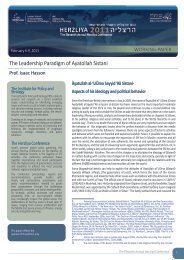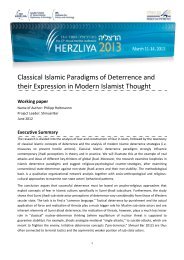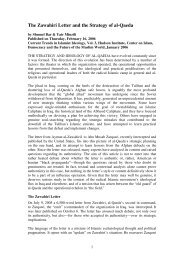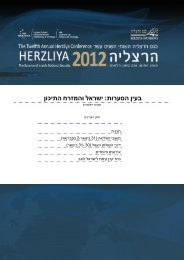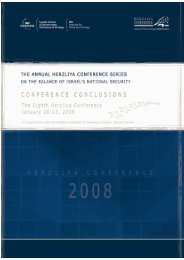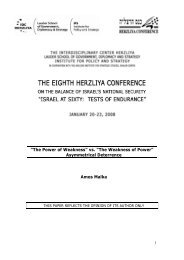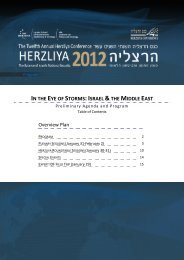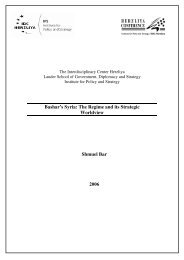Iran: Cultural Values, Self images and Negotiation Behavior
Iran: Cultural Values, Self images and Negotiation Behavior
Iran: Cultural Values, Self images and Negotiation Behavior
You also want an ePaper? Increase the reach of your titles
YUMPU automatically turns print PDFs into web optimized ePapers that Google loves.
<strong>Iran</strong>: <strong>Cultural</strong> <strong>Values</strong>, <strong>Self</strong>-<strong>images</strong> <strong>and</strong> Negotiating <strong>Behavior</strong>Non-verbal CommunicationCommunication between <strong>Iran</strong>ians is high-context; i.e., communication is allusive<strong>and</strong> indirect not only in the choice of words utilized, but in the dependence of theinterpretation of the message on the context in which it is transmitted: non-verbalclues, staging <strong>and</strong> setting of the act of communication, <strong>and</strong> the choice of the bearer ofthe message. Regarding the latter aspect, one may paraphrase Marshall McLuhan insaying that in <strong>Iran</strong> frequently “the messenger is the message.” While <strong>Iran</strong>ians whointeract with the West on a regular basis are aware of the low-context nature ofWestern (<strong>and</strong> particularly American) styles of communication, many tend to infernon-verbal clues from the behavior of their Western interlocutors according to <strong>Iran</strong>iancriteria.The gamut of non-verbal communication in <strong>Iran</strong>ian interaction is extremely wide<strong>and</strong> complex. It includes aspects of proxemics, h<strong>and</strong> <strong>and</strong> body gestures, eye contact,etc. The concatenation of these gestures clearly indicates intimacy between the twopersons, or their perception of each one's hierarchal inferiority or superiority.<strong>Iran</strong>ian social protocol places great importance on seating; placing a guest near adoor is indicative of his low rank or a low degree of welcome. Honored guests areusually seated to the right of the host. In ancient <strong>Iran</strong>ian protocol, the seating of aguest on the left side of the primary host (especially in a royal court <strong>and</strong> the like) is anindication of the guest's predominant status on the one h<strong>and</strong>, <strong>and</strong> assumed friendship,on the other h<strong>and</strong>. 113 In the modern <strong>Iran</strong>ian Majlis, members are seated according totheir rank, rather than their party affiliation.Body contact <strong>and</strong> free posture <strong>and</strong> behavior are not perceived as ice breakers in<strong>Iran</strong>ian culture, but a custom of samimiyat (intimacy) alone. Therefore,demonstrations of conviviality <strong>and</strong> gregariousness between non-intimates are notgenerally effective vis-à-vis <strong>Iran</strong>ian interlocutors (especially within groups). Suchgestures (pats on the back, frivolous body contact) are perceived as carrying apatronizing message. 114 When employed towards senior officials in the presence oftheir subordinates, it may have a demeaning effect (presenting the senior <strong>Iran</strong>ian asintimate or inferior to the foreigner).Head <strong>and</strong> h<strong>and</strong> gestures in <strong>Iran</strong>ian culture differ somewhat from most Westernmodels. For example, raising the head (a half nod) has a meaning of disagreement ordissatisfaction, while lowering the head is an expression of affirmation; a Westernstylethumbs up is an obscene gesture; holding one's head down <strong>and</strong> placing the h<strong>and</strong>on the heart with a slight bow is a sign of acknowledgement of the other party's socialpre-eminence. <strong>Iran</strong>ians, however, do not expect foreigners to copy <strong>Iran</strong>ian etiquette.113 It is said that Cyrus first began to place men on his left h<strong>and</strong> as a sign of respect, because that side isthe weaker side, <strong>and</strong> therefore the most exposed to danger. Sir John Chardin, Travels in Persia, 1673-1677. 2 (London: Argonaut Press, 1927, reprinted 1988, Unabridged Dover republication).114 It is interesting to note that even in times of mourning, <strong>Iran</strong>ians do not engage in physical acts ofconsolation (hugs, etc.), but rather maintain dignified “face.”30



